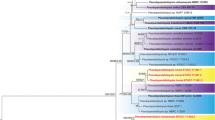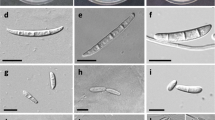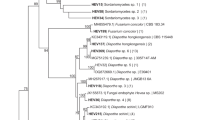Abstract
Phyllosticta capitalensis is an endophyte and weak plant pathogen with a worldwide distribution presently known from 70 plant families. This study isolated P. capitalensis from different host plants in northern Thailand, and determined their different life modes. Thirty strains of P. capitalensis were isolated as endophytes from 20 hosts. An additional 30 strains of P. capitalensis from other hosts and geographic locations were also obtained from established culture collections. Phylogenetic analysis using ITS, ACT and TEF gene data confirmed the identity of all isolates. Pathogenicity tests with five strains of P. capitalensis originating from different hosts were completed on their respective host plants. In all cases there was no infection of healthy leaves, indicating that this endophyte does not cause disease on healthy, unstressed host plants. That P. capitalensis is often isolated as an endophyte has important implications in fungal biology and plant health. Due to its endophytic nature, P. capitalensis is commonly found associated with lesions of plants, and often incorrectly identified as a species of quarantine importance, which again has implications for trade in agricultural and forestry production.




Similar content being viewed by others

References
Agostini JP, Peres NA, Mackenzie SJ, Adaskaveg JE, Timmer LW (2006) Effect of fungicides and storage conditions on postharvest development of citrus black spot and survival of Guignardia citricarpa in fruit tissues. Plant Dis 90:1419–1424
Aly AH, Debbab A, Kjer J, Proksch P (2010) Fungal endophytes from higher plants: a prolific source of phytochemicals and other bioactive natural products. Fungal Divers 41:1–16
Anderson CSR, Dominique G, Ana PTU, Rita TOC, Isabela SA, Carlos RRM, Aristóteles GN (2011) Foliar endophytic fungi from Hevea brasiliensis and their antagonism on Microcyclus ulei. Fungal Divers 47:75–84
Baayen R, Bonants P, Verkley G, Carroll G, Van Der Aa H, De Weerdt M, Van Brouwershaven I, Schutte G, Maccheroni W Jr, De Blanco C (2002) Nonpathogenic isolates of the citrus black spot fungus, Guignardia citricarpa, identified as a cosmopolitan endophyte of woody plants, G. mangiferae (Phyllosticta capitalensis). Phytopathology 92(5):464–477
Bensch K, Braun U, Groenewald JZ, Crous PW (2012) The genus Cladosporium. Stud Mycol 72:1–401
Bissett J (1986) Discochora yuccae sp. nov. with Phyllosticta and Leptodothiorella synanamorphs. Can J Bot 64:1720–1726
Botella L, Diez JJ (2011) Phylogenetic diversity of fungal endophytes in Spanish stands of Pinus halepensis. Fungal Divers 47:9–18
Chomnunti P, Schoch CL, Aguirre-Hudson B, Ko-Ko TW, Hongsanan S, Jones EBG, Kodsueb R, Phookamsak R, Chukeatirote E, Bahkali AH, Hyde KD (2011) Capnodiaceae. Fungal Divers 51:103–134
Crous PW, Verkleij GJM, Groenewald JZ (2009) In: Samson RA (ed) Fungal biodiversity, vol 1, CBS laboratory manual series. Centraalbureau voor Schimmelcultures, Utrecht
Damm U, Cannon PF, Woudenberg JHC, Crous PW (2012a) The Colletotrichum acutatum species complex. Stud Mycol 73:37–113
Damm U, Cannon PF, Woudenberg JHC, Johnston PR, Weir BS, Tan YP, Shivas RG, Crous PW (2012b) The Colletotrichum boninense species complex. Stud Mycol 73:1–36
de Gruyter J, Woudenberg JHC, Aveskamp MM, Verkley GJM, Groenewald JZ, Crous PW (2013) Redisposition of Phoma-like anamorphs in Pleosporales. Stud Mycol 75:1–36
De Hoog GS, Van Den Gerrits EAHG (1998) Molecular diagnostics of clinical strains of filamentous Basidiomycetes. Mycoses 41:183–189
Debbab A, Aly AH, Proksch P (2011) Bioactive secondary metabolites from endophytes and associated marine derived fungi. Fungal Divers 49:1–12
Debbab A, Aly AH, Proksch P (2012) Endophytes and associated marine derived fungi—ecological and chemical perspectives. Fungal Divers 57:45–83
Devarajan PT, Suryanarayanan TS (2006) Evidence for the role of phytophagous insects in dispersal of non-grass fungal endophytes. Fungal Divers 23:111–119
Fisher PJ, Petrini O (1992) Fungal saprobes and pathogens as endophytes of rice (Oryza sativa L.). New Phytol 120:137–143
Fröhlich J, Hyde KD (1995) Guignardia candeloflamma sp. nov. causing leaf spots of Pinanga sp. Mycol Res 99:110–112
Glienke C, Pereira O, Stringari D, Fabris J, Kava−Cordeiro V, Galli−Terasawa L, Cunnington J, Shivas R, Groenewald J, Crous PW (2011) Endophytic and pathogenic Phyllosticta species, with reference to those associated with citrus black spot. Persoonia 26:47–56
Glienke-Blanco C, Aguilar-Vildoso CI, Vieira MLC, Barroso PAV, Azevedo JL (2002) Genetic variability in the endophytic fungus Guignardia citricarpa isolated from citrus plants. Genet Mol Biol 25:251–255
Guo LD, Hyde KD, Liew ECY (1998) A method to promote sporulation in palm endophytic fungi. Fungal Divers 1:109–113
Guo LD, Hyde KD, Liew ECY (2001) Detection and taxonomic placement of endophytic fungi within frond tissues of Livistona chinensis based on rDNA sequences. Mol Phylogenet Evol 20:1–13
Guo LD, Huang GR, Wang Y, He WH, Zheng WH, Hyde KD (2003) Molecular identification of white morphotype strains of endophytic fungi from Pinus tabulaeformis. Mycol Res 107(6):680–688
Heinig U, Scholz S, Jennewein S (2013) Getting to the bottom of taxol biosynthesis by fungi. Fungal Divers. doi:10.1007/s13225-013-0228-7
Hennings P (1908) Fungi S. Paulenses IV a cl. Puttemans collecti. Hedwigia 48:1–20
Hofstetter V, Buyck B, Croll D, Viret O, Couloux A, Gindro K (2012) What if esca disease of grapevine were not a fungal disease? Fungal Divers 54:51–67
Huang WY, Cai YZ, Hyde KD, Corke H, Sun M (2008) Biodiversity of endophytic fungi associated with 29 traditional Chinese medicinal plants. Fungal Divers 33:61–75
Huelsenbeck JP, Ronquist FR (2001) MrBayes: Bayesian inference of phylogenetic trees. Biometrics 17:754–755
Hyde KD, Soytong K (2007) Understanding microfungal diversity-a critique. Cryptog Mycolog 28:281–289
Hyde KD, Soytong K (2008) The fungal endophyte dilemma. Fungal Divers 33:163–173
Krohn K, Ullah Z, Hussain H, Flörke U, Schulz B, Draeger S, Pescitelli G, Salvadori P, Antus S, Kurtán T (2007) Massarilactones E-G, new metabolites from the endophytic fungus Coniothyrium sp., associated with the plant Artimisia maritime. Chirality 19:464–470
Kumaran RS, Muthumary J, Hur B (2008) Production of taxol from Phyllosticta spinarum, an endophytic fungus of Cupressus sp. Eng Life Sci 8:438–446
Kuo K, Hoch HC (1996) The parasitic relationship between Phyllosticta ampelicida and Vitis vinifera. Mycologia 88:626–634
Lima JS, Figueiredo JG, Gomes RG, Stringari D, Goulin EH, Adamoski D, Kava-Cordeiro V, Galli-Terasawa LV, Glienke C (2012) Genetic diversity of Colletotrichum spp. an endophytic fungi in a medicinal plant, Brazilian pepper tree. ISRN Microbiol. doi:10.5402/2012/215716
Maharachchikumbura SSN, Guo LD, Chukeatirote E, Bahkali AH, Hyde KD (2011) Pestalotiopsis—morphology, phylogeny, biochemistry and diversity. Fungal Divers 50:167–187
Maharachchikumbura SSN, Guo LD, Cai L, Chukeatirote E, Wu WP, Sun X, Crous PW, Bhat DJ, McKenzie EHC, Bahkali AH, Hyde KD (2012) A Multi-locus backbone tree for Pestalotiopsis, with a polyphasic characterization of 14 new species. Fungal Divers 56:95–129
Meyer L, Jacobs R, Kotzé JM, Truter M, Korsten L (2012) Detection and molecular identification protocols for Phyllosticta citricarpa from citrus matter. S Afr J Sci. doi:10.4102/sajs.v108i3/4.602
Motohashi K, Inaba S, Anzai K, Takamatsu S, Nakashima C (2009) Phylogenetic analyses of Japanese species of Phyllosticta sensu stricto. Mycoscience 50:291–302
Okane I, Nakagiri A, Ito T (2001) Identity of Guignardia sp. inhabiting ericaceous plants. Can J Bot 79:101–109
Okane I, Lumyong S, Nakagiri A, Ito T (2003) Extensive host range of an endophytic fungus, Guignardia endophyllicola (anamorph: Phyllosticta capitalensis). Mycoscience 44:353–363
Orlandelli RC, Alberto RN, Rubin Filho CJ, Pamphile JA (2012) Diversity of endophytic fungal community associated with Piper hispidum (Piperaceae) leaves. Genet Mol Res 11:1575–1585
Pandey AK, Reddy M, Sudhakara S, Trichur S (2003) ITS-RFLP and ITS sequence analysis of a foliar endophytic Phyllosticta from different tropical trees. Mycol Res 108:974–978
Paul I, Van Jaarsveld AS, Korsten L, Hattingh V (2005) The potential global geographical distribution of citrus black spot caused by Guignardia citricarpa (Kiely): likelihood of disease establishment in the European Union. Crop Prot 24:297–308
Petrini O (1984) Endophytic fungi in British Ericaceae: a preliminary study. Trans Br Mycol Soc 83:510–512
Petrini O (1991) Fungal endophytes of tree leaves. In: Fokkema NJ, van den Heuvel (eds) Microbial ecology of leaves. Cambridge University Press, Cambridge, pp 185–187
Photita W, Lumyong S, Lumyong P, Hyde KD (2001) Endophytic fungi of wild banana (Musa acuminata) at Doi Suthep Pui National Park, in Thailand. Mycol Res 105:1508–1513
Photita W, Lumyong S, Lumyong P, McKenzie EHC, Hyde KD (2004) Are some endophytes of Musa acuminata latent pathogens? Fungal Divers 16:131–140
Photita W, Taylor PWJ, Ford R, Hyde KD, Lumyong S (2005) Morphological and molecular characterization of Colletotrichum species from herbaceous plants in Thailand. Fungal Divers 18:117–133
Phoulivong S, Cai L, Chen H, McKenzie EHC, Abdelsalam K, Chukeatirote E, Hyde KD (2010) Colletotrichum gloeosporioides is not a common pathogen on tropical fruits. Fungal Divers 44:33–43
Prihastuti H, Cai L, Chen H, McKenzie EHC, Hyde KD (2009) Characterization of Colletotrichum species associated with coffee berries in northern Thailand. Fungal Divers 39:89–109
Promputtha L, Jeewon R, Lumyong S, McKenzie EHC, Hyde KD (2005) Ribosomal DNA fingerprinting in the identification of non sporulating endophytes from Magnolia liliifera (Magnoliaceae). Fungal Divers 20:167–186
Purahong W, Hyde KD (2011) Effects of fungal endophytes on grass and non-grass litter decomposition rates. Fungal Divers 47:1–7
Rayner RW (1970) A mycological colour chart. Commonwealth Mycological Institute and British Mycological Society, Kew, 34 pp
Roy AJ (1968) Some fungi from Almora. Indian Phytopathol 20:340–348
Schulz B, Boyle C, Draeger S, Römmert AK (2002) Endophytic fungi: a source of novel biologically active secondary metabolites. Mycol Res 106:996–1004
Selim KA, El-Beih AA, Abdel-Rahman TM, El-Diwany AI (2012) Biology of endophytic fungi. CREAM 2:31–82
Shaw BD, Carroll GC, Hoch HC (2006) Generality of the prerequisite of conidium attachment to a hydrophobic substratum as a signal for germination among Phyllosticta species. Mycologia 98:186–194
Silva M, Pereira OL (2007) First report of Guignardia endophyllicola leaf blight on Cymbidium (Orchidaceae) in Brazil. Australas Plant Dis 2:31–32
Silva M, Pereira OL, Braga IF, Leli SM (2008) Leaf and pseudobulb diseases on Bifrenaria harrisoniae (Orchidaceae) caused by Phyllosticta capitalensis in Brazil. Australas Plant Dis 3:53–56
Singh KG (1980) A check list of host and disease in Malaysia. Bull Minist Agric Malays 154:280
Slippers B, Wingfield MJ (2007) Botryosphaeriaceae as endophytes and latent pathogens of woody plants: diversity, ecology and impact. Fungal Biol Rev 21:90–106
Strobel GA, Daisy B, Castillo U, Harper J (2004) Natural products from endophytic microorganisms. J Nat Prod 67:257–268
Summerell BA, Laurence MH, Liew ECY, Leslie JF (2010) Biogeography and phylogeography of Fusarium: a review. Fungal Divers 44:3–13
Sun X, Guo LD, Hyde KD (2011) Community composition of endophytic fungi in Acer truncatum and their role in decomposition. Fungal Divers 47:85–95
Suryanarayanan TS, Ravishankar JP, Venkatesan G, Murali TS (2004) Characterization of the melanin pigment of a cosmopolitan fungal endophyte. Mycol Res 108:974–978
Swofford DL (2003) Paup*: Phylogenetic analysis using parsimony (*and other methods), version 4.0. Sinauer Associates, Sunderland
Than PP, Jeewon R, Hyde KD, Pongsupasamit S, Mongkolporn O, Taylor PWJ (2008) Characterization and pathogenicity of Colletotrichum species associated with anthracnose on chilli (Capsicum spp.) in Thailand. Plant Pathol 57:562–572
Thompson S, Alvarez-Loayza P, Terborgh J, Katul G (2010) The effects of plant pathogens on tree recruitment in the Western Amazon under a projected future climate: a dynamical systems analysis. J Ecol 98:1434–1446
Udayanga D, Liu XX, McKenzie EHC, Chukeatirote E, Bahkali AH, Hyde KD (2011) The genus Phomopsis: biology, applications, species concepts and names of common phytopathogens. Fungal Divers 50:189–225
Udayanga D, Liu XX, Crous PW, McKenzie EHC, Chukeatirote E, Hyde KD (2012) A multi-locus phylogenetic evaluation of Diaporthe (Phomopsis). Fungal Divers 56:157–171
Ullrich CI, Kleespies RG, Enders M, Koch E (2009) Biology of the black rot pathogen, Guignardia bidwellii, its development in susceptible leaves of grapevine Vitis vinifera. J Kult 61:82–90
Van Der Aa HA (1973) Studies in Phyllosticta I. Stud Mycol 5:1–110
Van Der Aa H, Vanev S, Aptroot A, Summerbell R, Verkley G (2002) A revision of the species described in Phyllosticta. Centraalbureau voor Schimmelcultures, Utrecht
Wang X, Chen G, Huang F, Zhang J, Hyde KD, Li H (2012) Phyllosticta species associated with citrus diseases in China. Fungal Divers 52:209–224
White TJ, Bruns T, Lee S, Taylor J (1990) Amplification and direct sequencing of fungal ribosomal RNA genes for phylogenetics. In: Innes MA, Gelfand DH, Sninsky JJ, White TJ (eds) PCR protocols. A guide to methods and applications. Academic, San Diego, pp 315–322
Wikee S, Udayanga D, Crous PW, Chukeatirote E, McKenzie EHC, Bahkali AH, Dai DQ, Hyde KD (2011) Phyllosticta—an overview of current status of species recognition. Fungal Divers 46:171–182
Williams TH, Liu PSW (1976) A host list of plant disease in Sabah, Malaysia. Phytopathol Pap 19:1–67
Wong MH, Crous PW, Henderson J, Groenewald JZ, Drenth A (2012) Phyllosticta species associated with freckle disease of banana. Fungal Divers 56:173–187
Wulandari NF, To−Anun C, Hyde KD, Duong L, De Gruyter J, Meffert J, Groenewald JZ, Crous PW (2009) Phyllosticta citriasiana sp. nov., the cause of Citrus tan spot of Citrus maxima in Asia. Fungal Divers 34:23–39
Wulandari NF, To-Anun C, Hyde KD (2010a) Guignardia morindae frog eye leaf spotting disease of Morinda citrifolia (Rubiaceae). Mycosphere 1(4):325–331
Wulandari NF, To-Anun C, Lei C, Abd-Elsalam KA, Hyde KD (2010b) Guignardia/Phyllosticta species on banana. Cryptog Mycol 31(4):403–418
Xu J, Aly AH, Guan HS, Wray V, Proksch P (2010) Pestalotiopsis a highly creative genus: chemistry and bioactivity of secondary metabolites. Fungal Divers 44:15–31
Xu YC, Yao DQ, Jian HW, Zheng Z, De LW, Jin DF, Bing CG (2011) Molecular identification of endophytic fungi from medicinal plant Huperzia serrata based on rDNA ITS analysis. World J Microbiol Biotechnol 27:495–503
Zhao J, Zhou L, Wang J, Shan T, Zhong L, Liu X, Gao X (2010) In: Mendez-Vilas A (ed), Current Research, Technology Education Topics in Applied Microbiology and Microbial biotechnology: Endophytic fungi for producing bioactive compounds originally from their host plants. p. 567–576
Acknowledgments
We are grateful to Dhanushka Udayanga and Sajeewa S.N. Maharachchikumbura for their assistance. This study was financially supported by the Thailand Research Fund through the Royal Golden Jubilee Ph. D. Program (Grant No. PHD/0198/2552) to S. Wikee and Kevin D. Hyde. The National Research Council of Thailand is thanked for the award of grant No 54201020004 to study the genus Phyllosticta in Thailand.
Author information
Authors and Affiliations
Corresponding author
Rights and permissions
About this article
Cite this article
Wikee, S., Lombard, L., Crous, P.W. et al. Phyllosticta capitalensis, a widespread endophyte of plants. Fungal Diversity 60, 91–105 (2013). https://doi.org/10.1007/s13225-013-0235-8
Received:
Accepted:
Published:
Issue Date:
DOI: https://doi.org/10.1007/s13225-013-0235-8



